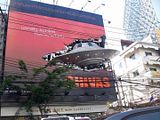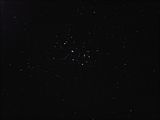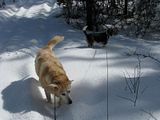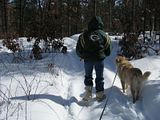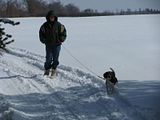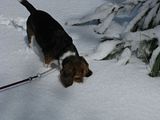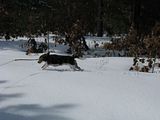31 Mar -1.8 20:10:10 WNW 56
- Quads, hailing from Grand Marsh Observatory atop Elk Castle Hill
Tuesday, March 31, 2009
In case you don't have a big pickup to tow your gooseneck trailer.
Here's an accident that hasn't happened yet . . .Class lll Hitch Install
Wouldn't you love to see how the trip went, reckon he ended up doin' some off roadin' somewhere. Check the 'hills' in the background.
She's hitched up and ready t o roll!! Amazin' how the extra weight smoothes out the ride. Needed to air up the rear tires a bit ('bout 160 psi).

Added some heavy-duty chain for extra support on the tailgate, (note the 'Heavy-Duty 'S' hooks to attach the chain) Also paid-up for some BIG 5/16 sheet metal screws to attach the frame to the tailgate. Yep, prob ably overkill, but didn't want the possibi lity of having an axerdent.
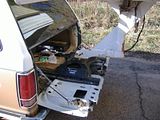
Most of the time was spent on the front porch whittling down that MASSIVE 4x4 to fit precisely into the ball mount receiver. Note: The 14'x14' piece of 3/8' plywood on the underside of the tailgate to distribute the load more evenly. 'YOU CAN'T BE TOO SAFE, YOU'AL L !!'. B'gosh it costs a little more, but jeez, you just can't be too safe.
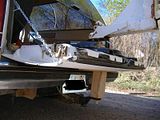
Thanks Rich!
- Quads, hailing from Grand Marsh Observatory atop Elk Castle Hill
Wouldn't you love to see how the trip went, reckon he ended up doin' some off roadin' somewhere. Check the 'hills' in the background.



Thanks Rich!
- Quads, hailing from Grand Marsh Observatory atop Elk Castle Hill
Monday, March 30, 2009
News From The Observatory

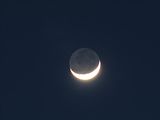
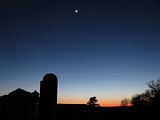


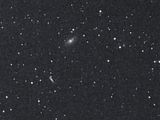
- Quads, hailing from Grand Marsh Observatory atop Elk Castle Hill
ISS Tonight
30 Mar -1.9 19:47:28 NW 52
- Quads, hailing from Grand Marsh Observatory atop Elk Castle Hill
- Quads, hailing from Grand Marsh Observatory atop Elk Castle Hill
Bat Hung On For a Ride Into Space
A small bat that was spotted blasting off with the space shuttle and clinging to the back side of Discovery's external fuel tank apparently held on throughout the launch.
NASA hoped the bat would fly away before the spacecraft's Sunday evening liftoff, but photos from the launch now show the bat holding on for dear life throughout the fiery ride.
"He did change the direction he was pointing from time to time throughout countdown but ultimately never flew away," states a NASA memo obtained by SPACE.com. "Infrared imagery shows he was alive and not frozen like many would think ... Liftoff imagery analysis confirmed that he held on until at least the vehicle cleared [the] tower before we lost sight of him."
Officials at NASA's Kennedy Space Center in Cape Canaveral, Fla., where Discovery launched from a seaside pad, said the bat's outlook after launch appears grim.
"Based on images and video, a wildlife expert who provides support to the center said the small creature was a free tail bat that likely had a broken left wing and some problem with its right shoulder or wrist," NASA officials said Tuesday. "The animal likely perished quickly during Discovery's climb into orbit."
Because the Kennedy Space Center is also home to Florida's Merritt Island National Wildlife Refuge, NASA's launch pads are equipped with several countermeasures, including warning sirens, to ward off birds and other wildlife. NASA also relies on radar to make sure large flocks of birds won't be struck by the shuttle during liftoff.
But the bat on Discovery's tank did not budge, even after engine ignition.
The bat was perched between one quarter and one third of the way up on the north side of the fuel tank, which is the side that faces away from the orbiter. NASA estimated the surface temperature of the tank at that location was between 58 and 70 degrees Fahrenheit, even though the canister was filled with super-cold liquid hydrogen and liquid oxygen.
In the hours before Discovery's liftoff, NASA's Final Inspection Team (called the "ICE team") investigated whether the creature would pose a risk to the shuttle if its body impacted the orbiter's sensitive heat shield tiling. Ultimately, NASA officials signed a waiver confirming that the bat was safe to fly with.
"The bat eventually became 'Interim Problem Report 119V-0080' after the ICE team finished their walkdown," the memo said. "Systems Engineering and Integration performed a debris analysis on him and ultimately a Launch Commit Criteria waiver to ICE-01 was written to accept the stowaway."
This isn't the first time a bat has attempted to travel into space. Another bat was seen clinging to the side of the external tank attached to the shuttle Endeavour on its STS-72 flight in 1996. That one maybe have been a bit more cautious, though: It flew away to safety right before launch.
Coincidentally, an astronaut aboard that flight, Koichi Wakata of Japan, also flew on Discovery this week, making him the first spaceflyer to share two rides with bats. Discovery's STS-119 mission is headed to the International Space Station to drop off the final segment of the lab's backbone truss and set of solar array panels.
NASA officials said a bat also set down on the external tank for the shuttle Columbia during its STS-90 mission in 1998. That bat also flitted away to safety during liftoff, they added.
source....
NASA hoped the bat would fly away before the spacecraft's Sunday evening liftoff, but photos from the launch now show the bat holding on for dear life throughout the fiery ride.
"He did change the direction he was pointing from time to time throughout countdown but ultimately never flew away," states a NASA memo obtained by SPACE.com. "Infrared imagery shows he was alive and not frozen like many would think ... Liftoff imagery analysis confirmed that he held on until at least the vehicle cleared [the] tower before we lost sight of him."
Officials at NASA's Kennedy Space Center in Cape Canaveral, Fla., where Discovery launched from a seaside pad, said the bat's outlook after launch appears grim.
"Based on images and video, a wildlife expert who provides support to the center said the small creature was a free tail bat that likely had a broken left wing and some problem with its right shoulder or wrist," NASA officials said Tuesday. "The animal likely perished quickly during Discovery's climb into orbit."
Because the Kennedy Space Center is also home to Florida's Merritt Island National Wildlife Refuge, NASA's launch pads are equipped with several countermeasures, including warning sirens, to ward off birds and other wildlife. NASA also relies on radar to make sure large flocks of birds won't be struck by the shuttle during liftoff.
But the bat on Discovery's tank did not budge, even after engine ignition.
The bat was perched between one quarter and one third of the way up on the north side of the fuel tank, which is the side that faces away from the orbiter. NASA estimated the surface temperature of the tank at that location was between 58 and 70 degrees Fahrenheit, even though the canister was filled with super-cold liquid hydrogen and liquid oxygen.
In the hours before Discovery's liftoff, NASA's Final Inspection Team (called the "ICE team") investigated whether the creature would pose a risk to the shuttle if its body impacted the orbiter's sensitive heat shield tiling. Ultimately, NASA officials signed a waiver confirming that the bat was safe to fly with.
"The bat eventually became 'Interim Problem Report 119V-0080' after the ICE team finished their walkdown," the memo said. "Systems Engineering and Integration performed a debris analysis on him and ultimately a Launch Commit Criteria waiver to ICE-01 was written to accept the stowaway."
This isn't the first time a bat has attempted to travel into space. Another bat was seen clinging to the side of the external tank attached to the shuttle Endeavour on its STS-72 flight in 1996. That one maybe have been a bit more cautious, though: It flew away to safety right before launch.
Coincidentally, an astronaut aboard that flight, Koichi Wakata of Japan, also flew on Discovery this week, making him the first spaceflyer to share two rides with bats. Discovery's STS-119 mission is headed to the International Space Station to drop off the final segment of the lab's backbone truss and set of solar array panels.
NASA officials said a bat also set down on the external tank for the shuttle Columbia during its STS-90 mission in 1998. That bat also flitted away to safety during liftoff, they added.
source....
Sunday, March 29, 2009
I Stand Corrected!
The Adams NAPA was open this morning, just like JR suggested to me that it was. But not for much longer. The young guy that owns it has been bought out by the co-op. He said that once they move it into the old True Value building and take it over, then it will most likely NOT be open on Sundays anymore.
The brakes are fixed, for now. All the other brake lines look like they could blow out at any moment, but I did buy extra just in case. Anyway, with Mrs. Reverend running the brake peddle and me laying under the truck working the bleeder screws, we got every last drop of air out of it. The brakes feel like factory original once again!
Now maybe I'll head out in the woods and do some cutting, while the stupid snow melts again.
- Quads, hailing from Grand Marsh Observatory atop Elk Castle Hill
The brakes are fixed, for now. All the other brake lines look like they could blow out at any moment, but I did buy extra just in case. Anyway, with Mrs. Reverend running the brake peddle and me laying under the truck working the bleeder screws, we got every last drop of air out of it. The brakes feel like factory original once again!
Now maybe I'll head out in the woods and do some cutting, while the stupid snow melts again.
- Quads, hailing from Grand Marsh Observatory atop Elk Castle Hill
News From The Observatory
Finally, on Friday night we had clear skies! I was able to complete a couple pictures I've been working on, and make progress on a few others.
Unfortunately the brakes went out on my truck yesterday morning, so I've been busy working on that and haven't had any time to upload anything. I'm still working on the brakes. But right now I'm waiting. Since I live IN THE MIDDLE OF NOWHERE, where the auto parts stores are barely open half a day on Saturdays and not at all on Sundays, I am waiting until after 9:00am to travel away from THE MIDDLE OF NOWHERE to get to a store that is open for business. I don't like spending money in Adams anyway, if I don't have to. They don't seem like they want the business very badly.
In case you were foolish enough to miss it! 3/27 Moon.
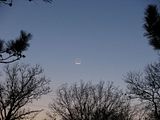

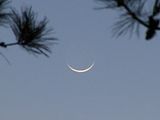

The Beehive Cluster.

The Flame Nebula. It's real faint, next to the leftmost bright star in this image. I think if I spent more time on this one, it might come out better. Unfortunately Orion is moving out of position for my observing site now, until next year.

This is the Flame Nebula cropped from a full size, brighter version.
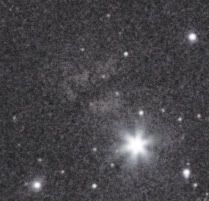
- Quads, hailing from Grand Marsh Observatory atop Elk Castle Hill
Unfortunately the brakes went out on my truck yesterday morning, so I've been busy working on that and haven't had any time to upload anything. I'm still working on the brakes. But right now I'm waiting. Since I live IN THE MIDDLE OF NOWHERE, where the auto parts stores are barely open half a day on Saturdays and not at all on Sundays, I am waiting until after 9:00am to travel away from THE MIDDLE OF NOWHERE to get to a store that is open for business. I don't like spending money in Adams anyway, if I don't have to. They don't seem like they want the business very badly.







- Quads, hailing from Grand Marsh Observatory atop Elk Castle Hill
Computer programmer from Finland has lost finger replaced with USB drive
A computer programmer from Finland who lost his ring finger in a motorcycle accident has had it replaced with a USB drive.
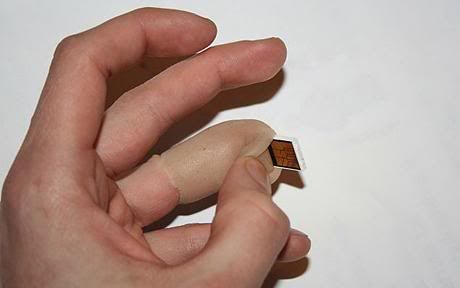
Jerry Jalava has built a special prosthetic finger which contains computer storage for photos, movies and other useful files.
While the prosthetic looks like a normal finger Jerry can peel it back from the 'nail' and plug it into the USB slot on his computer using it as an additional hard drive.
The software developer from Helsinki lost his finger last summer after crashing his one week old Ducati Monster 696 motorbike.
He was rushed to Helsinki Hospital where he was examined by a hand surgeon who said they were unable to save it and amputated half of the finger.
When Jerry told doctors what he did for a living they joked he should have a USB 'finger drive' but that was good enough for him, and he set about making one.
Using a traditional prosthetic finger Jerry has been able embed a 'USB key' - like the ones used in traditional flash drives - giving him the world's only two gigabyte finger.
The finger is not permanently attached to his hand meaning it can be removed when plugged into a computer.
"It is not attached permanently in to my body, it is a removable prosthetic which has USB memorystick inside it," said Jerry.
"When I'm using the USB, I just leave my finger inside the slot and pick it up after I'm ready."
Jerry said he is already thinking about upgrading his faux finger to include more storage and wireless technology.
"I'm planning to use anther prosthetic as a shell for the next version, which will have removable fingertip and an RFID tag," he added.
source....

Jerry Jalava has built a special prosthetic finger which contains computer storage for photos, movies and other useful files.
While the prosthetic looks like a normal finger Jerry can peel it back from the 'nail' and plug it into the USB slot on his computer using it as an additional hard drive.
The software developer from Helsinki lost his finger last summer after crashing his one week old Ducati Monster 696 motorbike.
He was rushed to Helsinki Hospital where he was examined by a hand surgeon who said they were unable to save it and amputated half of the finger.
When Jerry told doctors what he did for a living they joked he should have a USB 'finger drive' but that was good enough for him, and he set about making one.
Using a traditional prosthetic finger Jerry has been able embed a 'USB key' - like the ones used in traditional flash drives - giving him the world's only two gigabyte finger.
The finger is not permanently attached to his hand meaning it can be removed when plugged into a computer.
"It is not attached permanently in to my body, it is a removable prosthetic which has USB memorystick inside it," said Jerry.
"When I'm using the USB, I just leave my finger inside the slot and pick it up after I'm ready."
Jerry said he is already thinking about upgrading his faux finger to include more storage and wireless technology.
"I'm planning to use anther prosthetic as a shell for the next version, which will have removable fingertip and an RFID tag," he added.
source....
ISS Tonight
29 Mar -2.2 20:50:06 WNW 69
- Quads, hailing from Grand Marsh Observatory atop Elk Castle Hill
- Quads, hailing from Grand Marsh Observatory atop Elk Castle Hill
Saturday, March 28, 2009
ISS Tonight
28 Mar -1.7 20:26:10 NW 44
- Quads, hailing from Grand Marsh Observatory atop Elk Castle Hill
- Quads, hailing from Grand Marsh Observatory atop Elk Castle Hill
if you have car insurance....prepare to be rear-ended....an opinion column by Senator Dale Schultz
The state legislature’s non-partisan Legislative Fiscal Bureau is unearthing provisions buried in the budget introduced last month by Governor Jim Doyle.
For example, the bureau’s Summary of the Governor’s Budget Recommendations, available on my website at http://budget.senatordaleschultz.com, puts the light to provisions that you pay dearly for by raising the cost of your car insurance.
In a minute we’ll see why trial attorneys are the vocal advocates for these bad ideas. First, let’s consider why Wisconsin drivers currently enjoy the third lowest car insurance rates of all fifty states.
Our rates are low because our driver financial responsibility law is progressive public policy. Under the law, you lose your driver’s license and vehicle registration if you’re found responsible and can’t cover damages in a crash. Having car insurance makes you financially responsible. The carrot and stick approach, plus relatively few uninsured drivers in our state, combine to give us affordable rates.
The law sets minimum coverage levels at $25,000 bodily injury per person, $50,000 bodily injury per accident, and $10,000 property damage. Trial attorneys love the Governor for trying to raise the minimum to $100,000, $300,000 and $25,000 respectively.
Since the current 25/50/10 limits cover total damages in ninety percent of all claims, why do the trial attorneys want us to have unnecessary coverage? The answer is coming, but there’s more to the story.
If you have car insurance and the trial attorneys get their way, in a few months you’ll be forced to buy underinsured motorist coverage at $100,000 per person and $300,000 per accident. Today, underinsured coverage is optional!
Trial attorneys are also praising the Governor for tucking in the budget more car insurance changes to mandate “stacking”, broaden the definition of “underinsured motor vehicle” and prohibit reducing clauses. Each of these policy changes will further raise your cost for car insurance.
These policy changes will raise everyone’s car insurance costs leading some drivers to drop coverage altogether. Buckle up and be on the defensive; you’ll be sharing the road with more uninsured drivers.
It’s obvious these public policy issues have no business in a fiscal budget. But it’s an old trick to stick unpopular items in a budget when the courage is lacking to vote for the items separately.
Fact: Democrat legislators control Wisconsin’s Assembly and Senate and if they fail to help me yank these mandates out of the budget, you and other responsible drivers will soon have the nation’s highest minimum car insurance levels and we’ll go from the third lowest to among the highest cost states for car insurance.
Rural drivers would be hit harder than urban and suburban drivers by these changes. The more miles you drive, the higher your insurance cost. And rural residents drive many more miles for work, school and everywhere else. It’s a cruel plan for rural families with no public transit and household incomes averaging far below an area like Madison.
Please ask your insurance agent how these changes will affect you and family members. Then ask your state legislators to join me in standing up for you instead of special interests on this issue.
So, where will your additional dollars go if the trial attorneys win and your car insurance costs jump? Bet on a windfall for the trial attorneys. With higher insurance coverage, we’ll see many more claims litigated and attorneys will receive higher settlements from your insurance company and win more big awards from juries.
source....
For example, the bureau’s Summary of the Governor’s Budget Recommendations, available on my website at http://budget.senatordaleschultz.com, puts the light to provisions that you pay dearly for by raising the cost of your car insurance.
In a minute we’ll see why trial attorneys are the vocal advocates for these bad ideas. First, let’s consider why Wisconsin drivers currently enjoy the third lowest car insurance rates of all fifty states.
Our rates are low because our driver financial responsibility law is progressive public policy. Under the law, you lose your driver’s license and vehicle registration if you’re found responsible and can’t cover damages in a crash. Having car insurance makes you financially responsible. The carrot and stick approach, plus relatively few uninsured drivers in our state, combine to give us affordable rates.
The law sets minimum coverage levels at $25,000 bodily injury per person, $50,000 bodily injury per accident, and $10,000 property damage. Trial attorneys love the Governor for trying to raise the minimum to $100,000, $300,000 and $25,000 respectively.
Since the current 25/50/10 limits cover total damages in ninety percent of all claims, why do the trial attorneys want us to have unnecessary coverage? The answer is coming, but there’s more to the story.
If you have car insurance and the trial attorneys get their way, in a few months you’ll be forced to buy underinsured motorist coverage at $100,000 per person and $300,000 per accident. Today, underinsured coverage is optional!
Trial attorneys are also praising the Governor for tucking in the budget more car insurance changes to mandate “stacking”, broaden the definition of “underinsured motor vehicle” and prohibit reducing clauses. Each of these policy changes will further raise your cost for car insurance.
These policy changes will raise everyone’s car insurance costs leading some drivers to drop coverage altogether. Buckle up and be on the defensive; you’ll be sharing the road with more uninsured drivers.
It’s obvious these public policy issues have no business in a fiscal budget. But it’s an old trick to stick unpopular items in a budget when the courage is lacking to vote for the items separately.
Fact: Democrat legislators control Wisconsin’s Assembly and Senate and if they fail to help me yank these mandates out of the budget, you and other responsible drivers will soon have the nation’s highest minimum car insurance levels and we’ll go from the third lowest to among the highest cost states for car insurance.
Rural drivers would be hit harder than urban and suburban drivers by these changes. The more miles you drive, the higher your insurance cost. And rural residents drive many more miles for work, school and everywhere else. It’s a cruel plan for rural families with no public transit and household incomes averaging far below an area like Madison.
Please ask your insurance agent how these changes will affect you and family members. Then ask your state legislators to join me in standing up for you instead of special interests on this issue.
So, where will your additional dollars go if the trial attorneys win and your car insurance costs jump? Bet on a windfall for the trial attorneys. With higher insurance coverage, we’ll see many more claims litigated and attorneys will receive higher settlements from your insurance company and win more big awards from juries.
source....
Friday, March 27, 2009
UFOs photographed over London
Strange shapes have been photographed hovering over London leading to speculation they could be UFOs.
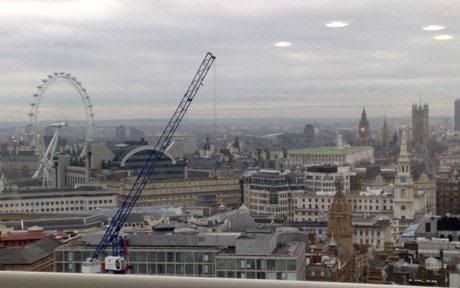
Derek Burdon was left stunned when he took a scenic pictures of the UK capital then noticed four flying saucers on the far right of the picture.
Mr Burdon took the photographs 16 floors up on the roof top of Orion House in Covent Garden in the morning.
Although invisible to the naked eye, the shapes can be clearly seen on the picture.
Derek, 40, of Leverington, Cambs, said: "We couldn't believe it when we came to look at the photo. I just thought I would take some scenic shots of the London Eye and also Big Ben.
"There was nothing unusual in the photo and it was only when we flicked through them later that we saw them and then it started a big UFO debate.
"I have not tampered with it and you would not be able to fake it. It was taken on my mobile and I guess I am just lucky to have it. These shapes were not visible to the naked eye so it's not as if I was looking for them."
In Feburary video footage of a UFO hovering above the British coastline was captured by holidaymakers in Somerset.
Caravaners were left baffled when the mysterious cylinder hovered over a busy campsite in Brean, Somerset.
But experts dismissed the strange moving shape as a weather balloon.
source....

Derek Burdon was left stunned when he took a scenic pictures of the UK capital then noticed four flying saucers on the far right of the picture.
Mr Burdon took the photographs 16 floors up on the roof top of Orion House in Covent Garden in the morning.
Although invisible to the naked eye, the shapes can be clearly seen on the picture.
Derek, 40, of Leverington, Cambs, said: "We couldn't believe it when we came to look at the photo. I just thought I would take some scenic shots of the London Eye and also Big Ben.
"There was nothing unusual in the photo and it was only when we flicked through them later that we saw them and then it started a big UFO debate.
"I have not tampered with it and you would not be able to fake it. It was taken on my mobile and I guess I am just lucky to have it. These shapes were not visible to the naked eye so it's not as if I was looking for them."
In Feburary video footage of a UFO hovering above the British coastline was captured by holidaymakers in Somerset.
Caravaners were left baffled when the mysterious cylinder hovered over a busy campsite in Brean, Somerset.
But experts dismissed the strange moving shape as a weather balloon.
source....
Venus
The planet Venus passes between Earth and the Sun today, so it is lost from sight. It will return to view as the "morning star" in a few days.
- Quads, hailing from Grand Marsh Observatory atop Elk Castle Hill
- Quads, hailing from Grand Marsh Observatory atop Elk Castle Hill
Thursday, March 26, 2009
Blogger Status
Update: This maintenance has been moved to today, Thursday (3/26), at 4:00PM PDT.
Blogger will be unavailable for about 10 minutes.
Posted by Jessica at 15:12 PDT
Blogger will be unavailable for about 10 minutes.
Posted by Jessica at 15:12 PDT
ISS Tonight
26 Mar -1.1 21:07:36 NW 37
- Quads, hailing from Grand Marsh Observatory atop Elk Castle Hill
- Quads, hailing from Grand Marsh Observatory atop Elk Castle Hill
Wednesday, March 25, 2009
Under The Weather
Wow! Just getting over a nasty flu bug. Started with terrible headaches a few days ago (which for me is nothing unusual anyway) then progressed to nausea, abdominal cramps, and frequent bathroom trips. I thought I was going to croak yesterday. Finally today I have been able to eat a little something.
I guess it's going around, but I don't know where I would have gotten it. I don't go anywhere and nobody comes to visit. I suppose the girls could have brought it home.
March is a bad month for me. It's the month that I needed heart surgery, then a couple years after that I ended up in the hospital in March again with life-threatening pneumonia. One more week of March and I should have it made, until next year!
- Quads, hailing from Grand Marsh Observatory atop Elk Castle Hill
I guess it's going around, but I don't know where I would have gotten it. I don't go anywhere and nobody comes to visit. I suppose the girls could have brought it home.
March is a bad month for me. It's the month that I needed heart surgery, then a couple years after that I ended up in the hospital in March again with life-threatening pneumonia. One more week of March and I should have it made, until next year!
- Quads, hailing from Grand Marsh Observatory atop Elk Castle Hill
Sasquatch linked to mysterious footprints
A paranormal researcher in northwestern B.C. claimed on Wednesday he has photographic evidence that sasquatches exist.
Brian Vike said he has a photo of a very large footprint along with samples of hair and blood from the mythical creature.
The Houston-based UFO researcher said he received a phone call last Sunday from a resident in Moricetown, 400 kilometres west of Prince George.
"I made the 90-minute drive up there, and I was amazed at what I saw," Vike said. "I've been on some of those turkey runs, when there's nothing to see.
"But there were footprints, 17 1/2 inches in length, that went on for a long ways."
Vike said the snow around the footprints was untouched.
"There were no tracks around to show that somebody was trying to pull a gag," he said.
Vike, who tracks UFO sightings, said he was even more excited when he found blood in one of the prints.
"I'm sending it off for testing in Saskatchewan and Ohio. We also have a hair sample."
Sasquatches are said to be apelike creatures that live in the wilderness and avoid civilization.
Like the yeti and the ogopogo, sightings are frequently reported, but no conclusive proof of their existence has ever been found.
source....
Brian Vike said he has a photo of a very large footprint along with samples of hair and blood from the mythical creature.
The Houston-based UFO researcher said he received a phone call last Sunday from a resident in Moricetown, 400 kilometres west of Prince George.
"I made the 90-minute drive up there, and I was amazed at what I saw," Vike said. "I've been on some of those turkey runs, when there's nothing to see.
"But there were footprints, 17 1/2 inches in length, that went on for a long ways."
Vike said the snow around the footprints was untouched.
"There were no tracks around to show that somebody was trying to pull a gag," he said.
Vike, who tracks UFO sightings, said he was even more excited when he found blood in one of the prints.
"I'm sending it off for testing in Saskatchewan and Ohio. We also have a hair sample."
Sasquatches are said to be apelike creatures that live in the wilderness and avoid civilization.
Like the yeti and the ogopogo, sightings are frequently reported, but no conclusive proof of their existence has ever been found.
source....
Tuesday, March 24, 2009
As for the cutting down of trees for firewood, what's not to like?
Wood differs fundamentally from fossil fuels. You find it at ground level – no need to drill or dig. It sequesters carbon perpetually. When you cut down trees, you mimic nature. When you burn wood, you mimic nature. Natural Resources puts it this way: “As a tree grows, it absorbs carbon dioxide from the air and stores it in the wood as carbon. When wood is burned, carbon dioxide is released to the atmosphere. The same amount of carbon dioxide would be released if the tree died and was left to rot.” (Wood is roughly 50 per cent carbon.)
Managed properly, forests are thus a never-ending source of an essentially benign fossil fuel. Cutting down trees and burning them, rather than leaving them to die and rot, compresses the length of the natural “life cycle” of the forest or woodlot. But as long as new trees are planted to replace trees cut down, the circle need never be broken.
Indeed, some authorities assert that, on a life cycle basis from seedling to cordwood, a clean-burning stove or fireplace can now heat your home more efficiently, and with less environmental impact, than any other fuel option.
Environmentalists get frightfully confused by forests, often causing politicians to get confused (or frightened) as well.
source....
Managed properly, forests are thus a never-ending source of an essentially benign fossil fuel. Cutting down trees and burning them, rather than leaving them to die and rot, compresses the length of the natural “life cycle” of the forest or woodlot. But as long as new trees are planted to replace trees cut down, the circle need never be broken.
Indeed, some authorities assert that, on a life cycle basis from seedling to cordwood, a clean-burning stove or fireplace can now heat your home more efficiently, and with less environmental impact, than any other fuel option.
Environmentalists get frightfully confused by forests, often causing politicians to get confused (or frightened) as well.
source....
Monday, March 23, 2009
ISS DODGES MORE DEBRIS:
On Sunday, March 22nd, space shuttle Discovery used its steering jets to move the International Space Station (ISS) out of the way of a speeding 4-inch piece of space junk, a metal fragment from a spent Chinese rocket engine. Without the maneuver, the object would have made a close approach to the ISS during today's spacewalk. This is the second time this month that the ISS has taken evasive action to avoid orbital debris.
- Quads, hailing from Grand Marsh Observatory atop Elk Castle Hill
- Quads, hailing from Grand Marsh Observatory atop Elk Castle Hill
Caravaggio was early 'photographer'
Caravaggio used an early form of photography to create his masterpieces - 200 years before the invention of the camera, a researcher has claimed.
Roberta Lapucci said the Italian artist - noted for his chiaroscuro (light and shadow) paintings - used "techniques that are the basis of photography".
It was already known he worked in a "darkroom" and illuminated his models through a hole in the ceiling.
But Ms Lapucci believes the image was also projected on a canvas and "fixed".
Light-sensitive substances applied to the canvas would have "fixed" the image for around 30 minutes, allowing Caravaggio to paint the image with broad strokes using white lead mixed with chemicals and minerals that were visible in the dark.
Ms Lapucci, who is a teacher at the prestigious Studio Art Centers International in Florence, is the first researcher to suggest the 16th century painter treated the canvas with light-sensitive substances.
She believes he could have used a photoluminescent powder from crushed fireflies, which was used at the time to create special effects in theatre productions.
"There is lots of proof, notably the fact that Caravaggio never made preliminary sketches. So it is plausible that he used these 'projections' to paint," she said.
Noting that "an abnormal number of his subjects were left-handed," Lapucci said: "That could be explained by the fact that the image projected on the canvas was backwards."
She added: "This anomaly disappears in the artist's later works, a sign that the instruments he used were improving. Also thanks to technical progress, his paintings gain a lot in depth of field over the years."
Ms Lapucci said the use of such techniques did not detract from the artist's work.
"His mastery of certain techniques before his time in no way diminishes his genius.
"To the contrary, clearly, you can't just project images on a canvas and copy them to become a Caravaggio."
source....
Roberta Lapucci said the Italian artist - noted for his chiaroscuro (light and shadow) paintings - used "techniques that are the basis of photography".
It was already known he worked in a "darkroom" and illuminated his models through a hole in the ceiling.
But Ms Lapucci believes the image was also projected on a canvas and "fixed".
Light-sensitive substances applied to the canvas would have "fixed" the image for around 30 minutes, allowing Caravaggio to paint the image with broad strokes using white lead mixed with chemicals and minerals that were visible in the dark.
Ms Lapucci, who is a teacher at the prestigious Studio Art Centers International in Florence, is the first researcher to suggest the 16th century painter treated the canvas with light-sensitive substances.
She believes he could have used a photoluminescent powder from crushed fireflies, which was used at the time to create special effects in theatre productions.
"There is lots of proof, notably the fact that Caravaggio never made preliminary sketches. So it is plausible that he used these 'projections' to paint," she said.
Noting that "an abnormal number of his subjects were left-handed," Lapucci said: "That could be explained by the fact that the image projected on the canvas was backwards."
She added: "This anomaly disappears in the artist's later works, a sign that the instruments he used were improving. Also thanks to technical progress, his paintings gain a lot in depth of field over the years."
Ms Lapucci said the use of such techniques did not detract from the artist's work.
"His mastery of certain techniques before his time in no way diminishes his genius.
"To the contrary, clearly, you can't just project images on a canvas and copy them to become a Caravaggio."
source....
Sunday, March 22, 2009
Leaving work early
Three girls all worked in the same office with the same female Boss. Each
day, they noticed the boss left work early. One day, the girls decided that,
when the boss left, they would leave right behind her.
After all, she never called or came back to work, so how would she know
they went home early?
The brunette was thrilled to be home early. she did a little gardening,
spent playtime with her son, and went to bed early.
The redhead was elated to be able to get in a quick workout at the spa
before meeting a dinner date.
The blonde was happy to get home early and surprise her husband, but when
she got to her bedroom, she heard a muffled noise from inside.
Slowly and quietly, she cracked open the door and was mortified to see her
husband in bed with her boss! Gently she closed the door and crept out of
the house.
The next day, at their coffee break, the brunette and redhead planned to
leave early again, and they asked the blonde if she was going to go with
them.
"No way," the blonde exclaimed. "I almost got caught yesterday."
Thanks Matt!
- Quads, hailing from Grand Marsh Observatory atop Elk Castle Hill
day, they noticed the boss left work early. One day, the girls decided that,
when the boss left, they would leave right behind her.
After all, she never called or came back to work, so how would she know
they went home early?
The brunette was thrilled to be home early. she did a little gardening,
spent playtime with her son, and went to bed early.
The redhead was elated to be able to get in a quick workout at the spa
before meeting a dinner date.
The blonde was happy to get home early and surprise her husband, but when
she got to her bedroom, she heard a muffled noise from inside.
Slowly and quietly, she cracked open the door and was mortified to see her
husband in bed with her boss! Gently she closed the door and crept out of
the house.
The next day, at their coffee break, the brunette and redhead planned to
leave early again, and they asked the blonde if she was going to go with
them.
"No way," the blonde exclaimed. "I almost got caught yesterday."
Thanks Matt!
- Quads, hailing from Grand Marsh Observatory atop Elk Castle Hill
Saturday, March 21, 2009
A Nice Day To Be Outside!
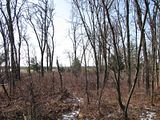
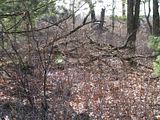
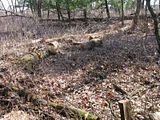
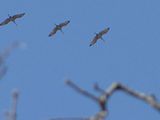
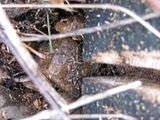

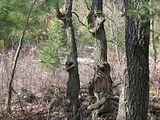
- Quads, hailing from Grand Marsh Observatory atop Elk Castle Hill
Early risers are in for a treat the next couple of mornings:
a conjunction between the crescent Moon and the planet Jupiter. They are quite low in the east about an hour before sunrise. Tomorrow, Jupiter is to the lower left of the Moon.
- Quads, hailing from Grand Marsh Observatory atop Elk Castle Hill
- Quads, hailing from Grand Marsh Observatory atop Elk Castle Hill
Friday, March 20, 2009
News From The Observatory
M35, This Month’s Most Beautiful Star Cluster
A superb object for small telescopes, the open star cluster Messier 35 in Gemini ranks as one of the most beautiful objects in the heavens. Even a modest scope reveals curved strands of stars twisting about a sparse central region, like bursting fireworks on a dark summer night.
• Messier 35 should top your list of things to see this month. No matter how often you observe this fine cluster, you will see new patterns and shapes in the interwined strands woven among this young cluster’s 300 stellar members.
• In binoculars, M35 looks like a tiny patch of frosted silver, with a few stars visible at most. In a 3-4-inch telescope you’ll see 40-50 stars, with more revealing themselves upon careful examination. In a 8-10-inch scope, the view of this cluster is awesome, with bright blue and white stars blazing in the field of view, along with a few red giants evolving off the main sequence.
• Unlike many star clusters, M35 has no central condensation. In fact, many observers see an absence of stars or a “hole” near the center of the cluster, which, with a little imagination, gives it the appearance of a sparkling sugar donut.
• M35 is barely visible to the naked eye in clear dark sky. And at magnitude 5.1, it appears quite faint because it’s spread out over an area of sky as large as the full Moon, just like the faint galaxy M33.
• To find M35, look just a couple degrees northwest of the star eta Geminorum, one of the feet of the constellation Gemini, the Twins. It’s coordinates are RA 6h09m, Dec +24d21m. The cluster is visible in the north and most of the southern hemisphere.
• The particulars: M35 is some 2,800 light years away, and spans a diameter of 30 light years. Like most open clusters, M35 is younger than most of the rocks in your back yard: it formed only 50 million years ago.
Map

source....
• Messier 35 should top your list of things to see this month. No matter how often you observe this fine cluster, you will see new patterns and shapes in the interwined strands woven among this young cluster’s 300 stellar members.
• In binoculars, M35 looks like a tiny patch of frosted silver, with a few stars visible at most. In a 3-4-inch telescope you’ll see 40-50 stars, with more revealing themselves upon careful examination. In a 8-10-inch scope, the view of this cluster is awesome, with bright blue and white stars blazing in the field of view, along with a few red giants evolving off the main sequence.
• Unlike many star clusters, M35 has no central condensation. In fact, many observers see an absence of stars or a “hole” near the center of the cluster, which, with a little imagination, gives it the appearance of a sparkling sugar donut.
• M35 is barely visible to the naked eye in clear dark sky. And at magnitude 5.1, it appears quite faint because it’s spread out over an area of sky as large as the full Moon, just like the faint galaxy M33.
• To find M35, look just a couple degrees northwest of the star eta Geminorum, one of the feet of the constellation Gemini, the Twins. It’s coordinates are RA 6h09m, Dec +24d21m. The cluster is visible in the north and most of the southern hemisphere.
• The particulars: M35 is some 2,800 light years away, and spans a diameter of 30 light years. Like most open clusters, M35 is younger than most of the rocks in your back yard: it formed only 50 million years ago.

source....
Spring Arrives
Spring arrives in the northern hemisphere at 6:44 a.m. CDT, when the Sun crosses the celestial equator from south to north at the vernal equinox. Over the next three months, the Sun will travel farther north, bringing longer, warmer days north of the equator.
- Quads, hailing from Grand Marsh Observatory atop Elk Castle Hill
- Quads, hailing from Grand Marsh Observatory atop Elk Castle Hill
Thursday, March 19, 2009
ISS Tonight
19 Mar -1.9 19:32:22 WSW 66
- Quads, hailing from Grand Marsh Observatory atop Elk Castle Hill
- Quads, hailing from Grand Marsh Observatory atop Elk Castle Hill
Wednesday, March 18, 2009
Emissions cloud future of wood-fired boilers
Scott Bradley proudly boasts that he is so opposed to dependence on foreign oil that he hasn’t bought a drop of heating oil in 12 years. Yet he keeps his house and his Mainline Heating and Supply store in the 70s every winter. He stays warm by burning native wood in hefty fireboxes called outdoor wood furnaces.
Bradley has become one of the top sellers of the country’s leading brand of such furnaces, Central Boiler, from his store in this wooded community about 20 miles from the Rhode Island line. He figures he has sold more than 1,300 in the last 12 years, including 400 to 500 to Rhode Islanders.
The furnaces pump heated water underground through insulated pipes to nearby buildings. Bradley says they are efficient and clean if operated properly. By his rough calculation, the stoves he has sold save about a million gallons of heating oil every year.
Unfortunately, he concedes, some are misused, just as some people drive cars improperly.
And as the stoves become more popular, more people are complaining that sooty smoke is invading their houses, making their lives miserable.
Two self-proclaimed victims of one of those stoves testified before the Rhode Island House Environment and Natural Resources Committee recently. Steve and Susan Charette, of Foster, said they haven’t been able to take their toddlers outdoors since last summer, when a neighbor fired up his outdoor boiler. They demanded state regulations to control emissions from such stoves.
North Smithfield and Woonsocket passed ordinances last year. Smithfield, North Kingstown and Narragansett are considering their own this year. Connecticut and Massachusetts have enacted regulations. Now, the Rhode Island House says it plans to act with its own legislation.
It may come as a surprise to some that Central Boiler doesn’t have a problem with that.
Former Attorney General Dennis J. Roberts II represented the company at the hearing in Rhode Island and said his client would support state regulations, with some amendments.
“This company is the largest manufacturer of this product,” said Roberts. “My client is very amenable to [Department of Environmental Management] regulations.”
DEM Director W. Michael Sullivan told the committee that if it wants the state to regulate the boilers, it will have to pass a law. Sullivan said his legal advisers don’t believe DEM is empowered to regulate residential boilers.
Sullivan said such a law should address boiler operations and the fact that many of the ones causing problems were installed without local permits and without guidance from licensed professionals.
Considering the time it takes to write regulations based on new state laws, he urged the legislators to act quickly so the DEM can be prepared to regulate the stoves by next fall.
Charette provided a video of the smoke billowing from his neighbor’s boiler.
“It’s not just a nuisance, it’s terrorism,” said Charette. He said he has taken his neighbor to court.
He said the General Assembly should declare a moratorium on boiler sales until it develops truly tough emission standards.
Charette said Europeans have developed the technology to clean up emissions from the stoves, but boiler makers have resisted that in the United States.
Susan Charette tearfully told the committee she is concerned about her twin toddlers.
“I can’t go outside with my kids. I can’t do anything with them,” she said. “I don’t know if you can imagine what that’s like.”
Molly Clark, of the American Lung Association, said the boilers not only cause asthma, they emit particles that cause other health problems for those who breathe them.
“The lung association isn’t opposed to wood burning as such, but it is against wood burning that is not properly controlled,” Clark said.
Representatives Raymond E. Gallison and Douglas W. Gablinske, both Bristol Democrats, are the lead sponsors of legislation to regulate the boilers. A different version failed last year. Gallison said at the hearing that he wants minimum stack heights and setbacks for the stoves. And he wants them installed only by licensed plumbers and electricians. He also wants to ensure compliance with federal emissions standards.
“In my opinion, it’s deplorable and we need to regulate it and regulate it now,” Gallison said.
Gablinske added: “We have a great interest in getting this passed before it explodes. It is a huge problem, and it will explode.”
Committee chairman Jan Malik agreed. “This is a big issue and we need to nip it in the bud.”
The only dissenting speaker was Al Bettencourt, of the Rhode Island Farm Bureau. He’s not opposed to some regulation, he said, but he’s concerned that the bill goes too far. What’s more, he asserted some boilers give off steam that people might mistake for smoke.
To Bradley, the wood boilers are practically a way of life — a way to rid the country of its dependence on foreign oil. He figures he saves 500 gallons of oil a month just with the boiler at his store.
The boilers are so big, you can feed them entire logs, rather than more expensive split wood.
When heating oil prices soared past $4 a gallon, he said, he got lots of new customers desperate to find another fuel.
“You wouldn’t believe how many customers we have and how much they love their boilers,” said Bradley.
“People are the problem — if they don’t burn responsibly,” he said. “It’s like people have the right to bear arms, but not to shoot people.”
“Wood smoke is dangerous,” said Bradley. “But so is cigarette smoke. Or fumes from your car.”
Despite the drawbacks of burning wood, Bradley insists they pale in comparison with the environmental costs of drilling for oil, transporting it, refining it and then burning it. And look at the costs of oil spills. You don’t get wood spills, he noted.
“Oil drove our country to its knees,” Bradley said.
Using the boilers on small lots is unthinkable, Bradley agreed. So is using a short smoke stack, or burning anything other than clean wood. Also, they should not be operated in the summer.
Bradley said he is concerned about having to comply with a variety of town regulations or outright bans. But moves by some states to require more efficient boilers don’t worry him. His company makes them too, although they cost more.
source....
Bradley has become one of the top sellers of the country’s leading brand of such furnaces, Central Boiler, from his store in this wooded community about 20 miles from the Rhode Island line. He figures he has sold more than 1,300 in the last 12 years, including 400 to 500 to Rhode Islanders.
The furnaces pump heated water underground through insulated pipes to nearby buildings. Bradley says they are efficient and clean if operated properly. By his rough calculation, the stoves he has sold save about a million gallons of heating oil every year.
Unfortunately, he concedes, some are misused, just as some people drive cars improperly.
And as the stoves become more popular, more people are complaining that sooty smoke is invading their houses, making their lives miserable.
Two self-proclaimed victims of one of those stoves testified before the Rhode Island House Environment and Natural Resources Committee recently. Steve and Susan Charette, of Foster, said they haven’t been able to take their toddlers outdoors since last summer, when a neighbor fired up his outdoor boiler. They demanded state regulations to control emissions from such stoves.
North Smithfield and Woonsocket passed ordinances last year. Smithfield, North Kingstown and Narragansett are considering their own this year. Connecticut and Massachusetts have enacted regulations. Now, the Rhode Island House says it plans to act with its own legislation.
It may come as a surprise to some that Central Boiler doesn’t have a problem with that.
Former Attorney General Dennis J. Roberts II represented the company at the hearing in Rhode Island and said his client would support state regulations, with some amendments.
“This company is the largest manufacturer of this product,” said Roberts. “My client is very amenable to [Department of Environmental Management] regulations.”
DEM Director W. Michael Sullivan told the committee that if it wants the state to regulate the boilers, it will have to pass a law. Sullivan said his legal advisers don’t believe DEM is empowered to regulate residential boilers.
Sullivan said such a law should address boiler operations and the fact that many of the ones causing problems were installed without local permits and without guidance from licensed professionals.
Considering the time it takes to write regulations based on new state laws, he urged the legislators to act quickly so the DEM can be prepared to regulate the stoves by next fall.
Charette provided a video of the smoke billowing from his neighbor’s boiler.
“It’s not just a nuisance, it’s terrorism,” said Charette. He said he has taken his neighbor to court.
He said the General Assembly should declare a moratorium on boiler sales until it develops truly tough emission standards.
Charette said Europeans have developed the technology to clean up emissions from the stoves, but boiler makers have resisted that in the United States.
Susan Charette tearfully told the committee she is concerned about her twin toddlers.
“I can’t go outside with my kids. I can’t do anything with them,” she said. “I don’t know if you can imagine what that’s like.”
Molly Clark, of the American Lung Association, said the boilers not only cause asthma, they emit particles that cause other health problems for those who breathe them.
“The lung association isn’t opposed to wood burning as such, but it is against wood burning that is not properly controlled,” Clark said.
Representatives Raymond E. Gallison and Douglas W. Gablinske, both Bristol Democrats, are the lead sponsors of legislation to regulate the boilers. A different version failed last year. Gallison said at the hearing that he wants minimum stack heights and setbacks for the stoves. And he wants them installed only by licensed plumbers and electricians. He also wants to ensure compliance with federal emissions standards.
“In my opinion, it’s deplorable and we need to regulate it and regulate it now,” Gallison said.
Gablinske added: “We have a great interest in getting this passed before it explodes. It is a huge problem, and it will explode.”
Committee chairman Jan Malik agreed. “This is a big issue and we need to nip it in the bud.”
The only dissenting speaker was Al Bettencourt, of the Rhode Island Farm Bureau. He’s not opposed to some regulation, he said, but he’s concerned that the bill goes too far. What’s more, he asserted some boilers give off steam that people might mistake for smoke.
To Bradley, the wood boilers are practically a way of life — a way to rid the country of its dependence on foreign oil. He figures he saves 500 gallons of oil a month just with the boiler at his store.
The boilers are so big, you can feed them entire logs, rather than more expensive split wood.
When heating oil prices soared past $4 a gallon, he said, he got lots of new customers desperate to find another fuel.
“You wouldn’t believe how many customers we have and how much they love their boilers,” said Bradley.
“People are the problem — if they don’t burn responsibly,” he said. “It’s like people have the right to bear arms, but not to shoot people.”
“Wood smoke is dangerous,” said Bradley. “But so is cigarette smoke. Or fumes from your car.”
Despite the drawbacks of burning wood, Bradley insists they pale in comparison with the environmental costs of drilling for oil, transporting it, refining it and then burning it. And look at the costs of oil spills. You don’t get wood spills, he noted.
“Oil drove our country to its knees,” Bradley said.
Using the boilers on small lots is unthinkable, Bradley agreed. So is using a short smoke stack, or burning anything other than clean wood. Also, they should not be operated in the summer.
Bradley said he is concerned about having to comply with a variety of town regulations or outright bans. But moves by some states to require more efficient boilers don’t worry him. His company makes them too, although they cost more.
source....
ISS Tonight
18 Mar -0.7 20:40:48 W 31
- Quads, hailing from Grand Marsh Observatory atop Elk Castle Hill
- Quads, hailing from Grand Marsh Observatory atop Elk Castle Hill
Tuesday, March 17, 2009
ISS Tonight
17 Mar -2.2 20:13:10 WSW 77
- Quads, hailing from Grand Marsh Observatory atop Elk Castle Hill
- Quads, hailing from Grand Marsh Observatory atop Elk Castle Hill
Debris near space station was bigger than reported
* Debris was 5 inches in diameter, not 1/3 of an inch
* Close encounter was with piece of rocket engine from '93
The piece of orbital space junk that forced three astronauts to briefly evacuate the International Space Station on Thursday was bigger than originally reported, NASA officials said on Friday.
The object, identified as a piece of rocket engine that flew in 1993, was about 5 inches (12.7 cm) in diameter, not .35 inches (0.89 cm).
Had it struck one of the pressurized modules aboard the $100 billion space station, the crew would have had only 10 minutes of air, said NASA spokesman Kelly Humphries.
Station commander Michael Fincke and flight engineers Yury Lonchakov and Sandra Magnus slipped inside a Russian Soyuz escape vehicle for about 10 minutes when the potentially destructive space litter came too close for comfort.
Even tiny objects pose a risk to satellites and spacecraft orbiting Earth. Because objects in orbit are moving on different paths, at different inclinations and at speeds of 17,500 miles (28,163 km) per hour and faster, something as small as a grain of sand can impact with the power of a bowling ball moving at 100 mph (160 kph), Humphries said.
NASA had expected the debris to come as close as 2.8 miles (4.5 km) to the station. As of Friday, officials still did not know exactly how close it came.
Radars used to keep track of debris in orbit will first have to get another good fix on its location, said Gene Stansbery, the orbital debris program manager at NASA's Johnson Space Center in Houston.
Stansbery said reports that the object was .009 meters (.35 inches) stemmed from a reference to its cross section, not its overall size. "Whoever put out that blurb misinterpreted that number," Stansbery said.
ADDITIONAL DEBRIS
Station crews have had to take temporary refuge in their escape ships fives times previously for orbital debris issues, said NASA spokesman Kyle Herring.
If time allows, NASA will maneuver the station to avoid coming within 25 meters (82 feet) of a piece of space junk. The path of the debris that flew by the station on Thursday was too uncertain to plot in time, Stansbery said.
With more than 500 additional pieces of debris now in orbit as a result of the crash last month between an Iridium communications satellite and a defunct Russian spacecraft, the U.S. space agency is analyzing new radar maps that can pinpoint objects as small as 0.79 inches (2 cm), Stansbery said.
source....
* Close encounter was with piece of rocket engine from '93
The piece of orbital space junk that forced three astronauts to briefly evacuate the International Space Station on Thursday was bigger than originally reported, NASA officials said on Friday.
The object, identified as a piece of rocket engine that flew in 1993, was about 5 inches (12.7 cm) in diameter, not .35 inches (0.89 cm).
Had it struck one of the pressurized modules aboard the $100 billion space station, the crew would have had only 10 minutes of air, said NASA spokesman Kelly Humphries.
Station commander Michael Fincke and flight engineers Yury Lonchakov and Sandra Magnus slipped inside a Russian Soyuz escape vehicle for about 10 minutes when the potentially destructive space litter came too close for comfort.
Even tiny objects pose a risk to satellites and spacecraft orbiting Earth. Because objects in orbit are moving on different paths, at different inclinations and at speeds of 17,500 miles (28,163 km) per hour and faster, something as small as a grain of sand can impact with the power of a bowling ball moving at 100 mph (160 kph), Humphries said.
NASA had expected the debris to come as close as 2.8 miles (4.5 km) to the station. As of Friday, officials still did not know exactly how close it came.
Radars used to keep track of debris in orbit will first have to get another good fix on its location, said Gene Stansbery, the orbital debris program manager at NASA's Johnson Space Center in Houston.
Stansbery said reports that the object was .009 meters (.35 inches) stemmed from a reference to its cross section, not its overall size. "Whoever put out that blurb misinterpreted that number," Stansbery said.
ADDITIONAL DEBRIS
Station crews have had to take temporary refuge in their escape ships fives times previously for orbital debris issues, said NASA spokesman Kyle Herring.
If time allows, NASA will maneuver the station to avoid coming within 25 meters (82 feet) of a piece of space junk. The path of the debris that flew by the station on Thursday was too uncertain to plot in time, Stansbery said.
With more than 500 additional pieces of debris now in orbit as a result of the crash last month between an Iridium communications satellite and a defunct Russian spacecraft, the U.S. space agency is analyzing new radar maps that can pinpoint objects as small as 0.79 inches (2 cm), Stansbery said.
source....
Monday, March 16, 2009
More Orion and Friends
Still working on a wide picture of Orion, Taurus, and the Seven Sisters. These are my best so far, an accumulation of three nights, a stack of 95 single pictures.
I think this is my best one so far. I might add more to it, as the weather allows, but time is running out for the winter constellations.

This is the same picture only brighter to show all possible stars. I don't think it looks as pretty as the other one, but it's interesting to see just how many stars there are that only the camera can show.
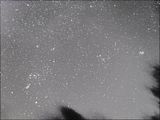
- Quads, hailing from Grand Marsh Observatory atop Elk Castle Hill


- Quads, hailing from Grand Marsh Observatory atop Elk Castle Hill
ISS Tonight
UPDATE: Tonight's flyby is a double, the ISS and the Shuttle close by.
16 Mar -1.4 19:46:23 SSW 33
- Quads, hailing from Grand Marsh Observatory atop Elk Castle Hill
16 Mar -1.4 19:46:23 SSW 33
- Quads, hailing from Grand Marsh Observatory atop Elk Castle Hill
It's springtime in the Necedah Wildlife Refuge!
Warm sun and wet, sloppy ATV routes were the rule for our ride yesterday. The snow is finally disappearing. The Yellow River is still more white than yellow, but the ice is breaking up.
We came across a tree harvester that had caught fire and burned up.
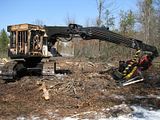
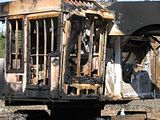
Ever wonder how the phone companies make so much money?
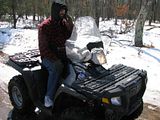
Hello? It's me, JR here on my phone.

Ha ha ha! Yup, still on the phone.
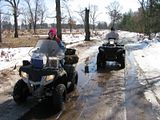
These pictures and more from our ride can be found on the home/picture page.
- Quads, hailing from Grand Marsh Observatory atop Elk Castle Hill





These pictures and more from our ride can be found on the home/picture page.
- Quads, hailing from Grand Marsh Observatory atop Elk Castle Hill
March 16th - a date to remember!
Mrs. Reverend and I have been together 22 years! And lovin' every minute of it!
I quit smoking 4 years ago and never looked back! And now I suffer from a slight case of "dicky-do", but oh well.
My Polaris Hawkeye ATV turns 2 years old! And 2500 miles.
- Quads, hailing from Grand Marsh Observatory atop Elk Castle Hill
I quit smoking 4 years ago and never looked back! And now I suffer from a slight case of "dicky-do", but oh well.
My Polaris Hawkeye ATV turns 2 years old! And 2500 miles.
- Quads, hailing from Grand Marsh Observatory atop Elk Castle Hill
NASA: Shuttle's Risk of Debris Strike Up 6 Percent
The recent surge in space junk created by an accidental satellite collision last month has bumped up the upcoming space shuttle mission's chances of taking a catastrophic hit, NASA officials said. However, the likelihood of the shuttle intercepting debris is still so low that mission managers don't foresee any problems.
Engineers analyzed how much danger would be posed to the shuttle Discovery's upcoming STS-119 flight, scheduled to launch March 11, by the new debris, which was created when a U.S. and a Russian communication satellite unexpectedly rammed into each other in orbit. The Feb. 10 smash-up produced two large clouds of shrapnel that are now circling the Earth, NASA said.
The investigation found that the new space junk raises Discovery's risk factor by 6 percent, giving it a chance of about 1 in 318 of being fatally hit by debris. Mission managers had estimated a similar figure shortly after the satellite collision, but said they had reviewed the risk in detail today.
"That is very comparable to almost all of the 14-day missions we fly," said John Shannon, NASA space shuttle program manager, at a briefing today.
The collision occurred about 490 miles (790 km) over Siberia. Discovery is due to fly up to 220 miles (354 km) above Earth, where it will dock with the International Space Station to deliver new solar array wings.
NASA is still assessing the risk to the upcoming Hubble repair space shuttle mission, targeted to fly in late May. The danger to this trip could be greater, managers said, because that shuttle is set to take its crew to an altitude of about 372 miles (600 km), putting it much closer to the range of the collision than the space station is.
"That didn't look so good, when they looked at that," Bill Gerstenmaier, NASA's space operations chief, has said.
source....
Engineers analyzed how much danger would be posed to the shuttle Discovery's upcoming STS-119 flight, scheduled to launch March 11, by the new debris, which was created when a U.S. and a Russian communication satellite unexpectedly rammed into each other in orbit. The Feb. 10 smash-up produced two large clouds of shrapnel that are now circling the Earth, NASA said.
The investigation found that the new space junk raises Discovery's risk factor by 6 percent, giving it a chance of about 1 in 318 of being fatally hit by debris. Mission managers had estimated a similar figure shortly after the satellite collision, but said they had reviewed the risk in detail today.
"That is very comparable to almost all of the 14-day missions we fly," said John Shannon, NASA space shuttle program manager, at a briefing today.
The collision occurred about 490 miles (790 km) over Siberia. Discovery is due to fly up to 220 miles (354 km) above Earth, where it will dock with the International Space Station to deliver new solar array wings.
NASA is still assessing the risk to the upcoming Hubble repair space shuttle mission, targeted to fly in late May. The danger to this trip could be greater, managers said, because that shuttle is set to take its crew to an altitude of about 372 miles (600 km), putting it much closer to the range of the collision than the space station is.
"That didn't look so good, when they looked at that," Bill Gerstenmaier, NASA's space operations chief, has said.
source....
Sunday, March 15, 2009
Discovery, Weather Looking Good For Launch
NASA managers said Saturday that space shuttle Discovery is ready for Sunday’s launch opportunity as repairs on a leaking gaseous hydrogen vent line are moving along smoothly.
“I think we’re in really good shape,” said Mike Moses, chairman of the Mission Management Team that reviewed the shuttle’s readiness.
Mike Leinbach, shuttle launch director, said the work to replace a suspect quick disconnect assembly on the launch pad is about three hours behind schedule, but that will not delay the countdown. Leak checks will be performed later tonight.
“We feel really good and we’re really excited about launching tomorrow,” Leinbach said.
The weather forecast continues to call for an 80 percent chance of acceptable conditions, said Kathy Winters, shuttle weather officer.
Launch controllers will begin preparing to pump fuel and oxygen into the external tank Sunday at 10:18 a.m. EDT. Launch time is 7:43 p.m.
source....
“I think we’re in really good shape,” said Mike Moses, chairman of the Mission Management Team that reviewed the shuttle’s readiness.
Mike Leinbach, shuttle launch director, said the work to replace a suspect quick disconnect assembly on the launch pad is about three hours behind schedule, but that will not delay the countdown. Leak checks will be performed later tonight.
“We feel really good and we’re really excited about launching tomorrow,” Leinbach said.
The weather forecast continues to call for an 80 percent chance of acceptable conditions, said Kathy Winters, shuttle weather officer.
Launch controllers will begin preparing to pump fuel and oxygen into the external tank Sunday at 10:18 a.m. EDT. Launch time is 7:43 p.m.
source....
Astronauts were ready to evacuate the ISS
Astronauts aboard the International Space Station took refuge inside their Russian-built Soyuz lifeboat Thursday when a potentially life-threatening piece of space debris zipped too close to their orbiting laboratory.
The three astronauts, two Americans and one Russian, moved into the station's attached Soyuz TMA-13 spacecraft at 12:35 p.m. EDT (1635 GMT) as a safety precaution in case the debris - a small piece of a spent satellite motor - slammed into the orbiting lab and ripped a hole in its outer hull. The astronauts were ready to evacuate the space station if the debris hit the station and depressurized its living space.
Notice of the incoming debris came overnight, too late for flight controllers to plan a maneuver to fire the station's thrusters and put more space between it and the space trash, NASA officials said. But the debris apparently did not impact the $100 billion orbiting lab as it flew 220 miles (354 km) above Earth.
"We're all happy the [debris] passed with no impact," NASA's Mission Control radioed up to the crew from the Johnson Space Center (JSC) in Houston. "That's great news."
NASA spokesperson Brandi Dean at JSC told SPACE.com that the astronauts did not fully close the hatches between the Soyuz and the rest of the space station during the precaution, but they were prepared to do so if required. The satellite motor remnant was expected to zoom past the station at a distance of about 2.4 miles (4 km), Dean said.
"The closure of the hatches ensures the safety of the crew and the ability to quickly depart the station in the unlikely event the debris collided with the station causing a depressurization," NASA officials said. "Moving the crew into the Soyuz is a precaution, as the probability of impact is low."
Space station commander Michael Fincke and flight engineer Sandra Magnus, both of NASA, and Russian cosmonaut Yury Lonchakov told Mission Control that they could not see the space debris, but were glad it missed the space station.
"Sandy kept her eyes out the Soyuz windows and we didn't see anything, of course," Fincke radioed down to Mission Control. "But we were wondering how close things were. We'd be interested in that."
Space debris threat
Dean said NASA flight controllers are refining their estimates to how close the debris came to the space station.
The wayward satellite motor part came from an outdated PAM-D rocket engine that was once used to boost a satellite from low-Earth orbit a few hundred miles above Earth out to a geosynchronous position about 22,300 miles (36,000 km) above the planet. The debris was small, just 1/3 of an inch long, and was flying at about 19,800 mph, NASA officials said. The space station orbits the Earth at about 17,500 mph.
The space station has fired its Russian rocket engines to avoid space junk before, and astronauts have sought shelter in their attached Soyuz spacecraft - which doubles as a lifeboat in emergencies - at least once before, she added.
"It has happened before," Dean said.
The last time astronauts sought refuge from space debris in their Soyuz spacecraft was on Nov. 17, 2008, when the remains of an old SL-12 rocket flew within 12 miles (19 km) of the space station, according to the European Space Agency. That debris event also did not impact the space station.
The satellite motor made its closest pass by the space station at 12:39 p.m. EDT (1639 GMT). By 12:46 p.m. EDT (1646 GMT), Fincke and his fellow crewmates were given the all clear to reenter the space station.
Space debris has been a growing threat for spacecraft in low-Earth orbit.
NASA officials said the recent Feb. 10 collision between a Russian military satellite and a U.S. communications satellite has increased the risk of debris impacts during a space shuttle mission by about 6 percent.
The unprecedented Feb. 10 collision occurred 490 miles (790 km) above Siberia and created two large clouds of debris in Earth orbit. Some of the debris particles are expected to start re-entering the Earth's atmosphere this week.
source....
The three astronauts, two Americans and one Russian, moved into the station's attached Soyuz TMA-13 spacecraft at 12:35 p.m. EDT (1635 GMT) as a safety precaution in case the debris - a small piece of a spent satellite motor - slammed into the orbiting lab and ripped a hole in its outer hull. The astronauts were ready to evacuate the space station if the debris hit the station and depressurized its living space.
Notice of the incoming debris came overnight, too late for flight controllers to plan a maneuver to fire the station's thrusters and put more space between it and the space trash, NASA officials said. But the debris apparently did not impact the $100 billion orbiting lab as it flew 220 miles (354 km) above Earth.
"We're all happy the [debris] passed with no impact," NASA's Mission Control radioed up to the crew from the Johnson Space Center (JSC) in Houston. "That's great news."
NASA spokesperson Brandi Dean at JSC told SPACE.com that the astronauts did not fully close the hatches between the Soyuz and the rest of the space station during the precaution, but they were prepared to do so if required. The satellite motor remnant was expected to zoom past the station at a distance of about 2.4 miles (4 km), Dean said.
"The closure of the hatches ensures the safety of the crew and the ability to quickly depart the station in the unlikely event the debris collided with the station causing a depressurization," NASA officials said. "Moving the crew into the Soyuz is a precaution, as the probability of impact is low."
Space station commander Michael Fincke and flight engineer Sandra Magnus, both of NASA, and Russian cosmonaut Yury Lonchakov told Mission Control that they could not see the space debris, but were glad it missed the space station.
"Sandy kept her eyes out the Soyuz windows and we didn't see anything, of course," Fincke radioed down to Mission Control. "But we were wondering how close things were. We'd be interested in that."
Space debris threat
Dean said NASA flight controllers are refining their estimates to how close the debris came to the space station.
The wayward satellite motor part came from an outdated PAM-D rocket engine that was once used to boost a satellite from low-Earth orbit a few hundred miles above Earth out to a geosynchronous position about 22,300 miles (36,000 km) above the planet. The debris was small, just 1/3 of an inch long, and was flying at about 19,800 mph, NASA officials said. The space station orbits the Earth at about 17,500 mph.
The space station has fired its Russian rocket engines to avoid space junk before, and astronauts have sought shelter in their attached Soyuz spacecraft - which doubles as a lifeboat in emergencies - at least once before, she added.
"It has happened before," Dean said.
The last time astronauts sought refuge from space debris in their Soyuz spacecraft was on Nov. 17, 2008, when the remains of an old SL-12 rocket flew within 12 miles (19 km) of the space station, according to the European Space Agency. That debris event also did not impact the space station.
The satellite motor made its closest pass by the space station at 12:39 p.m. EDT (1639 GMT). By 12:46 p.m. EDT (1646 GMT), Fincke and his fellow crewmates were given the all clear to reenter the space station.
Space debris has been a growing threat for spacecraft in low-Earth orbit.
NASA officials said the recent Feb. 10 collision between a Russian military satellite and a U.S. communications satellite has increased the risk of debris impacts during a space shuttle mission by about 6 percent.
The unprecedented Feb. 10 collision occurred 490 miles (790 km) above Siberia and created two large clouds of debris in Earth orbit. Some of the debris particles are expected to start re-entering the Earth's atmosphere this week.
source....
ISS Tonight
15 Mar -1.3 20:54:17 WSW 43
- Quads, hailing from Grand Marsh Observatory atop Elk Castle Hill
- Quads, hailing from Grand Marsh Observatory atop Elk Castle Hill
Saturday, March 14, 2009
News From The Observatory
Last night's sky was PERFECT! The seeing was absolutely the best it gets. It was a late night (or an early morning depending on which way you look at it). The stars had no twinkle at all, which is a good sign.
Mrs. Reverend is a star cluster hunter. Nebula are ok, galaxies are so-so, but she really wants to see the star clusters. And this is the one that started it all for her. The Beehive Cluster.

I think this section of the night sky is the best naked eye view anywhere or anytime of year. The Summer Milky Way is impressive, like a river of light, but nothing beats this arrangement of stars. Almost like they were purposely arranged that way. Here is Orion, Taurus, and The Seven Sisters.

- Quads, hailing from Grand Marsh Observatory atop Elk Castle Hill


- Quads, hailing from Grand Marsh Observatory atop Elk Castle Hill
Cannibalistic Jupiter ate its early moons
THE four giant "Galilean" moons orbiting Jupiter are the last survivors of at least five generations of moons that once circled the gas giant.
"All the other moons - and there could have been 20 or more - were devoured by the planet in the early days of the solar system," says Robin Canup of the Southwest Research Institute in Boulder, Colorado.
The four Galilean moons have played a key role in the history of science - their discovery by Galileo 400 years ago provided irrefutable evidence that not all bodies orbited the Earth. But until recently, nobody had suspected that Jupiter had once had many more moons.
Astronomers have long been aware of a mystery thrown up by simulations of the way Jupiter and its moons formed, says Canup. These models indicate that the mass of the debris disc around Jupiter, from which the moons formed, was several tens of a per cent of the mass of giant planet. And yet only 2 per cent is enough to make the moons we see today.
Now Canup and her colleague William Ward believe they know why. The extra mass can be explained if other moons formed while the debris disc was still present (www.arxiv.org/abs/0812.4995). "A key process is therefore the interaction between the growing moons and the disc material still flowing in from the solar system," says Canup. This interaction would have caused the early moons to spiral in towards Jupiter and eventually be "eaten".
This would explain the discrepancy in the earlier simulations, says Canup: as one set of moons was swallowed, a new set immediately began to form. "There could have been five generations of moons," she says. "The current Galilean moons formed just as the inflow of material into the disc from the solar system choked off, so they escaped the fate of their unfortunate predecessors."
According to Canup and Ward, in each generation the total mass of the moons was the same, but the number of moons could have varied. "We think something similar happened around Saturn, where the last generation contained one giant moon - Titan," says Canup.
This could have implications for the solar system as a whole. Rocky planets may take as long as 10 million years to aggregate, chunk by chunk. The process continues long after the debris disc around the sun has blown away, so these planets would not have been at risk of spiralling inwards.
In contrast, the gaseous cores of gas giants like Saturn and Jupiter condense out of the solar debris disc very quickly via gas shrinkage. This means they would have had time to interact with the debris disc. John Papaloizou of the University of Cambridge says it is entirely conceivable that the sun may have swallowed numerous gas cores before the current stable configuration of the solar system emerged.
source....
"All the other moons - and there could have been 20 or more - were devoured by the planet in the early days of the solar system," says Robin Canup of the Southwest Research Institute in Boulder, Colorado.
The four Galilean moons have played a key role in the history of science - their discovery by Galileo 400 years ago provided irrefutable evidence that not all bodies orbited the Earth. But until recently, nobody had suspected that Jupiter had once had many more moons.
Astronomers have long been aware of a mystery thrown up by simulations of the way Jupiter and its moons formed, says Canup. These models indicate that the mass of the debris disc around Jupiter, from which the moons formed, was several tens of a per cent of the mass of giant planet. And yet only 2 per cent is enough to make the moons we see today.
Now Canup and her colleague William Ward believe they know why. The extra mass can be explained if other moons formed while the debris disc was still present (www.arxiv.org/abs/0812.4995). "A key process is therefore the interaction between the growing moons and the disc material still flowing in from the solar system," says Canup. This interaction would have caused the early moons to spiral in towards Jupiter and eventually be "eaten".
This would explain the discrepancy in the earlier simulations, says Canup: as one set of moons was swallowed, a new set immediately began to form. "There could have been five generations of moons," she says. "The current Galilean moons formed just as the inflow of material into the disc from the solar system choked off, so they escaped the fate of their unfortunate predecessors."
According to Canup and Ward, in each generation the total mass of the moons was the same, but the number of moons could have varied. "We think something similar happened around Saturn, where the last generation contained one giant moon - Titan," says Canup.
This could have implications for the solar system as a whole. Rocky planets may take as long as 10 million years to aggregate, chunk by chunk. The process continues long after the debris disc around the sun has blown away, so these planets would not have been at risk of spiralling inwards.
In contrast, the gaseous cores of gas giants like Saturn and Jupiter condense out of the solar debris disc very quickly via gas shrinkage. This means they would have had time to interact with the debris disc. John Papaloizou of the University of Cambridge says it is entirely conceivable that the sun may have swallowed numerous gas cores before the current stable configuration of the solar system emerged.
source....
Friday, March 13, 2009
This weekend's weather forecast predicts an ATV ride!
Today: Mostly sunny, with a high near 38. Southwest wind between 5 and 10 mph.
Saturday: Sunny, with a high near 51. Southwest wind between 3 and 8 mph.
Sunday: Mostly sunny, with a high near 51. South wind between 3 and 7 mph.
Monday: A slight chance of rain and snow before 10am, then a slight chance of rain. Mostly cloudy, with a high near 57. Chance of precipitation is 20%.
- Quads, hailing from Grand Marsh Observatory atop Elk Castle Hill
Saturday: Sunny, with a high near 51. Southwest wind between 3 and 8 mph.
Sunday: Mostly sunny, with a high near 51. South wind between 3 and 7 mph.
Monday: A slight chance of rain and snow before 10am, then a slight chance of rain. Mostly cloudy, with a high near 57. Chance of precipitation is 20%.
- Quads, hailing from Grand Marsh Observatory atop Elk Castle Hill
Famed pastor predicts imminent catastrophe
A respected pastor, best-selling author and founder of a major ministry to teens predicts an imminent "earth-shattering calamity" centered in New York City that will spread to major urban areas across the country and around the world – part of what he sees as a judgment from God.
David Wilkerson, author of "The Cross and the Switchblade," a book about his ministry to troubled New York street kids that was later made into a movie starring Pat Boone, tells readers of his blog this weekend that he is "compelled by the Holy Spirit to send out an urgent message" about his prediction.
"An earth-shattering calamity is about to happen," he writes. "It is going to be so frightening, we are all going to tremble – even the godliest among us."
Wilkerson's vision is of fires raging through New York City.
"It will engulf the whole megaplex, including areas of New Jersey and Connecticut. Major cities all across America will experience riots and blazing fires – such as we saw in Watts, Los Angeles, years ago," he explains. "There will be riots and fires in cities worldwide. There will be looting – including Times Square, New York City. What we are experiencing now is not a recession, not even a depression. We are under God’s wrath. In Psalm 11 it is written, "If the foundations are destroyed, what can the righteous do?"
Wilkerson is the founding pastor of Times Square Church in New York City, where he launched a ministry to gang members and drug addicts in 1958. He is a highly regarded mentor to other pastors in evangelical circles and travels the world holding conferences for other Christian ministers.
"God is judging the raging sins of America and the nations," claims Wilkerson. "He is destroying the secular foundations." Wilkerson urges everyone to stockpile a 30-day supply of food and other necessities to deal with the catastrophe he foresees.
"I do not know when these things will come to pass, but I know it is not far off," Wilkerson concluded in his message. "I have unburdened my soul to you. Do with the message as you choose."
A past vice president of the Southern Baptist Convention is hoping believers pay attention to Wilkerson's message.
"I have known David Wilkerson for more than 25 years as well as many of his friends and associates," said Pastor Wiley Drake. "He is a godly man and I believe he is listening to God. I encourage each Christian to read and heed what God is saying through our brother."
source....
David Wilkerson, author of "The Cross and the Switchblade," a book about his ministry to troubled New York street kids that was later made into a movie starring Pat Boone, tells readers of his blog this weekend that he is "compelled by the Holy Spirit to send out an urgent message" about his prediction.
"An earth-shattering calamity is about to happen," he writes. "It is going to be so frightening, we are all going to tremble – even the godliest among us."
Wilkerson's vision is of fires raging through New York City.
"It will engulf the whole megaplex, including areas of New Jersey and Connecticut. Major cities all across America will experience riots and blazing fires – such as we saw in Watts, Los Angeles, years ago," he explains. "There will be riots and fires in cities worldwide. There will be looting – including Times Square, New York City. What we are experiencing now is not a recession, not even a depression. We are under God’s wrath. In Psalm 11 it is written, "If the foundations are destroyed, what can the righteous do?"
Wilkerson is the founding pastor of Times Square Church in New York City, where he launched a ministry to gang members and drug addicts in 1958. He is a highly regarded mentor to other pastors in evangelical circles and travels the world holding conferences for other Christian ministers.
"God is judging the raging sins of America and the nations," claims Wilkerson. "He is destroying the secular foundations." Wilkerson urges everyone to stockpile a 30-day supply of food and other necessities to deal with the catastrophe he foresees.
"I do not know when these things will come to pass, but I know it is not far off," Wilkerson concluded in his message. "I have unburdened my soul to you. Do with the message as you choose."
A past vice president of the Southern Baptist Convention is hoping believers pay attention to Wilkerson's message.
"I have known David Wilkerson for more than 25 years as well as many of his friends and associates," said Pastor Wiley Drake. "He is a godly man and I believe he is listening to God. I encourage each Christian to read and heed what God is saying through our brother."
source....
Thursday, March 12, 2009
MUFON to receive major funding from billionaire backer
Billionaire real estate investor and entrepreneur Robert Bigelow of Las Vegas is now betting his bucks on MUFON to find valuable new knowledge about alien propulsion systems.
Bigelow, who has long been known to give millions of dollars to fund serious UFO research, has just concluded a deal with MUFON whereby he will supply this organization with whatever it needs to be able to go out and bring back the hard evidence, not only to document the reality of UFOs interacting with us, but most importantly to gather the kind of information that will truly advance scientific understanding of this phenomenon.
This may well prove to be a historical occasion for MUFON and for the science of Ufology in general. MUFON since its inception has been a volunteer effort on the part of civilians who devote whatever spare time and energies they can afford in order to fulfill MUFON's stated mission of scientifically investigating the UFO phenomenon for the benefit of humanity.
Now for the first time MUFON's members are going to be paid to do their work. MUFON's agreement with Bigelow is to train and qualify a special rapid response team of Field Investigators who can be deployed within 24 hours to the scene of a major UFO event, the kind designated as Category 2 or 3 in the classification system devised by legendary UFO researcher Jacques Vallee. These are the rarer cases where either physical traces are left or physiological effects are caused in the witness.
Bigelow has hired 50 top-flight scientists to assist MUFON in this endeavor who will function as consultants and do expensive lab analysis of alien materials gathered at the location of a UFO event. Bigelow, who never does anything on a small scale, a few years ago founded BAASS (Bigelow Aerospace Advanced Space Studies) with the incredibly ambitious goal of putting a commercial hotel up in orbit around the earth. He thinks that even one category 2 or 3 case if properly investigated can yield significant scientific paydirt.
Whatever high-tech equipment needed by the investigators on the scene will be drop-shipped to them overnight by BAASS. These high-profile cases will be investigated using the strictest methods of scientific protocol.
Bigelow who has been known to keep his findings on the UFO subject secret has agreed per his contract with MUFON to hold nothing back from this organization that is revealed in the BAASS lab analysis of materials supplied by MUFON. This project which just launched on March 1 is code-named SIP (for Star Impact Project) . It is a pilot experiment and will be reviewed on June 30th to see if it has proven successful enough to warrant funding for the rest of the year.
Understandably there is a lot of excitement at MUFON Headquarters and among its membership. Now with this major infusion of funds from Bigelow, it will be better able than ever to carry out its stated mission. And Bigelow possibly will get what he wants to forward his goal.
How this will all work out is hard to guess. This is something that has never been tried before. MUFON and BAASS are moving into unchartered territory here. In any case, Bigelow's investing so heavily in MUFON's ability to make SIP a successful search and find operation for greater knowledge about alien technology is some extremely good PR for MUFON whose credibility can be expected to take a significant leap forward in the eyes of the general public.
source....
Bigelow, who has long been known to give millions of dollars to fund serious UFO research, has just concluded a deal with MUFON whereby he will supply this organization with whatever it needs to be able to go out and bring back the hard evidence, not only to document the reality of UFOs interacting with us, but most importantly to gather the kind of information that will truly advance scientific understanding of this phenomenon.
This may well prove to be a historical occasion for MUFON and for the science of Ufology in general. MUFON since its inception has been a volunteer effort on the part of civilians who devote whatever spare time and energies they can afford in order to fulfill MUFON's stated mission of scientifically investigating the UFO phenomenon for the benefit of humanity.
Now for the first time MUFON's members are going to be paid to do their work. MUFON's agreement with Bigelow is to train and qualify a special rapid response team of Field Investigators who can be deployed within 24 hours to the scene of a major UFO event, the kind designated as Category 2 or 3 in the classification system devised by legendary UFO researcher Jacques Vallee. These are the rarer cases where either physical traces are left or physiological effects are caused in the witness.
Bigelow has hired 50 top-flight scientists to assist MUFON in this endeavor who will function as consultants and do expensive lab analysis of alien materials gathered at the location of a UFO event. Bigelow, who never does anything on a small scale, a few years ago founded BAASS (Bigelow Aerospace Advanced Space Studies) with the incredibly ambitious goal of putting a commercial hotel up in orbit around the earth. He thinks that even one category 2 or 3 case if properly investigated can yield significant scientific paydirt.
Whatever high-tech equipment needed by the investigators on the scene will be drop-shipped to them overnight by BAASS. These high-profile cases will be investigated using the strictest methods of scientific protocol.
Bigelow who has been known to keep his findings on the UFO subject secret has agreed per his contract with MUFON to hold nothing back from this organization that is revealed in the BAASS lab analysis of materials supplied by MUFON. This project which just launched on March 1 is code-named SIP (for Star Impact Project) . It is a pilot experiment and will be reviewed on June 30th to see if it has proven successful enough to warrant funding for the rest of the year.
Understandably there is a lot of excitement at MUFON Headquarters and among its membership. Now with this major infusion of funds from Bigelow, it will be better able than ever to carry out its stated mission. And Bigelow possibly will get what he wants to forward his goal.
How this will all work out is hard to guess. This is something that has never been tried before. MUFON and BAASS are moving into unchartered territory here. In any case, Bigelow's investing so heavily in MUFON's ability to make SIP a successful search and find operation for greater knowledge about alien technology is some extremely good PR for MUFON whose credibility can be expected to take a significant leap forward in the eyes of the general public.
source....
Wednesday, March 11, 2009
Black River State Forest Conditions
Conditions as of Tuesday, March 10, 2009:
Winter recreation has come to a close at the state forest and ATV trails are now closed. Conditions are very icy on the trails making them unsafe for public use. Typically trails close for the year about March 15, but this year's date has been moved up due to unsafe conditions. ATV trails will reopen on May 15 for the spring and summer season.
Please note that this spring we will begin a long-term project to upgrade all of the wetland crossings on the trail system. This will include the replacement and addition of culverts and raising the trail surface 2-4 feet in many of these areas, which will result in short term closures of some sections of the trail. We will try and limit closings to weekdays as much as possible and keep an updated map of trail section closings on the website once this begins. This project will protect the long term sustainability of the trail system and lessen the frequency of trail closings due to large rainfall events.
source....
Winter recreation has come to a close at the state forest and ATV trails are now closed. Conditions are very icy on the trails making them unsafe for public use. Typically trails close for the year about March 15, but this year's date has been moved up due to unsafe conditions. ATV trails will reopen on May 15 for the spring and summer season.
Please note that this spring we will begin a long-term project to upgrade all of the wetland crossings on the trail system. This will include the replacement and addition of culverts and raising the trail surface 2-4 feet in many of these areas, which will result in short term closures of some sections of the trail. We will try and limit closings to weekdays as much as possible and keep an updated map of trail section closings on the website once this begins. This project will protect the long term sustainability of the trail system and lessen the frequency of trail closings due to large rainfall events.
source....
Windy
Wind speed of 47 mph this morning.
- Quads, hailing from Grand Marsh Observatory atop Elk Castle Hill
- Quads, hailing from Grand Marsh Observatory atop Elk Castle Hill
The Milky Way is relatively barren during March.
It forms a thin arch that stretches from north to south in mid-evening, with a dip toward the western horizon. We are looking away from the Milky Way's dense core toward a thinly populated region of the galaxy.
- Quads, hailing from Grand Marsh Observatory atop Elk Castle Hill
- Quads, hailing from Grand Marsh Observatory atop Elk Castle Hill
Tuesday, March 10, 2009
Pictures From Yesterday's Walk
Missing mobile found inside fish
A businessman who lost his mobile phone on a beach was amazed when it turned up - in the belly of a giant cod.
Andrew Cheatle thought it had been swept out to sea after it slipped from his pocket.
But a week later his girlfriend's mobile rang and it was fisherman Glen Kerley saying he'd found the phone in a 25lb fish, reports The Sun.
Andrew got the handset back, dried it out - and amazingly it still works.
Andrew, 45, said: "I was messing about with my dog and my phone must have fallen out and been swept out in the swell. I kept calling it but I gave up hope after a couple of days."
He was shopping for a new phone with girlfriend Rita Smith, 33, when her mobile went off.
She told him: "Your old mobile number is calling my phone."
Andrew continued: "She said some guy was going on about my phone and a cod so she handed it over to me and he told me where he had found it.
"I thought he was winding me up but he assured me he had caught a cod that morning and was gutting it for his fish stall and that my Nokia was inside it - a bit worse for wear."
Glen, of Worthing, West Sussex, said: "Cod are greedy fish - they'll eat anything. They have big heads and big mouths.
"I've found plastic cups, stones, teaspoons, batteries and I've also heard of someone finding false teeth in one.
"It was a bit smelly but I was glad to return it."
source....
Andrew Cheatle thought it had been swept out to sea after it slipped from his pocket.
But a week later his girlfriend's mobile rang and it was fisherman Glen Kerley saying he'd found the phone in a 25lb fish, reports The Sun.
Andrew got the handset back, dried it out - and amazingly it still works.
Andrew, 45, said: "I was messing about with my dog and my phone must have fallen out and been swept out in the swell. I kept calling it but I gave up hope after a couple of days."
He was shopping for a new phone with girlfriend Rita Smith, 33, when her mobile went off.
She told him: "Your old mobile number is calling my phone."
Andrew continued: "She said some guy was going on about my phone and a cod so she handed it over to me and he told me where he had found it.
"I thought he was winding me up but he assured me he had caught a cod that morning and was gutting it for his fish stall and that my Nokia was inside it - a bit worse for wear."
Glen, of Worthing, West Sussex, said: "Cod are greedy fish - they'll eat anything. They have big heads and big mouths.
"I've found plastic cups, stones, teaspoons, batteries and I've also heard of someone finding false teeth in one.
"It was a bit smelly but I was glad to return it."
source....
Monday, March 9, 2009
Police raid suspected cannabis factory - and find wood burning stove
Police raided a property after heat-seeking cameras identified a suspected cannabis factory – only to discover nothing more sinister than a wood-burning stove.
Officers obtained a search warrant and broke through a door at Colin Rowe's workshop in Huddersfield, Yorks, after an infra-red police helicopter camera picked up unusual heat patterns from the house.
They looked high and low for the cannabis plants, even breaking a flowerpot in the process, but found that the heat source was simply a stove used to warm the garage workshop where Mr Rowe restores cars in his spare time.
The 41-year-old college technician was furious when he returned home to find the damaged door and the warrant, which had been posted through his letterbox without an apology.
Mr Rowe said: "I find it quite disturbing that Wild West Yorkshire Police can do what they want. I think it is disgraceful, I didn't think the police would treat anyone like this without good reason," he said. "My dad was a police officer for 40 years and he's disgusted about this."
It appears Mr Rowe's crime prevention measures may have also heightened the police's suspicions. Bars on windows at the back of his property - which he fitted to keep burglars out - were seen as a sign that he could be a cannabis "farmer" keen to protect his illegal crop.
Mr Rowe, 41, who has no previous convictions, said: "I think it's a pretty poor way for them to behave given that I'm not the sort of person who's known to the police."
Commenting on the damage, he said: "There was a big hole in the door which was large enough to get your arm through, the hinges were bent, there were bits of wood on the floor and one of my plant pots was broken.
"There was a brush and shovel right by the door so, if they'd had any compassion, they would have at least swept up the mess.'
Mr Rowe went to his local police station in Huddersfield, West Yorkshire, to complain and spoke to the policewoman who applied for the warrant. She said a police helicopter "had noted the heat source from my home."
He added: "She said they sent a patrol to my house and found I had bars on the windows at the back. That's to prevent burglary - I don't think it's excessive.
"I've been given a form to claim compensation and I hope the police will pay for the damage."
A West Yorkshire Police spokesman confirmed officers executed a drugs warrant at 9.45 am last Friday. "During the execution of the warrant a door to an external building was forced. Officers located no drugs and arrangements were made for the door to be left secure.
"No entry was made by officers into the main house itself. It is standard policy that we will pay for repairs in such circumstances and we would be happy to discuss any concerns Mr Rowe has."
Mr Rowe shares the house with wife Beth, a 40-year-old health visitor. The door has cost £200 to repair and he has had to take time off work because of the police raid.
source....
Officers obtained a search warrant and broke through a door at Colin Rowe's workshop in Huddersfield, Yorks, after an infra-red police helicopter camera picked up unusual heat patterns from the house.
They looked high and low for the cannabis plants, even breaking a flowerpot in the process, but found that the heat source was simply a stove used to warm the garage workshop where Mr Rowe restores cars in his spare time.
The 41-year-old college technician was furious when he returned home to find the damaged door and the warrant, which had been posted through his letterbox without an apology.
Mr Rowe said: "I find it quite disturbing that Wild West Yorkshire Police can do what they want. I think it is disgraceful, I didn't think the police would treat anyone like this without good reason," he said. "My dad was a police officer for 40 years and he's disgusted about this."
It appears Mr Rowe's crime prevention measures may have also heightened the police's suspicions. Bars on windows at the back of his property - which he fitted to keep burglars out - were seen as a sign that he could be a cannabis "farmer" keen to protect his illegal crop.
Mr Rowe, 41, who has no previous convictions, said: "I think it's a pretty poor way for them to behave given that I'm not the sort of person who's known to the police."
Commenting on the damage, he said: "There was a big hole in the door which was large enough to get your arm through, the hinges were bent, there were bits of wood on the floor and one of my plant pots was broken.
"There was a brush and shovel right by the door so, if they'd had any compassion, they would have at least swept up the mess.'
Mr Rowe went to his local police station in Huddersfield, West Yorkshire, to complain and spoke to the policewoman who applied for the warrant. She said a police helicopter "had noted the heat source from my home."
He added: "She said they sent a patrol to my house and found I had bars on the windows at the back. That's to prevent burglary - I don't think it's excessive.
"I've been given a form to claim compensation and I hope the police will pay for the damage."
A West Yorkshire Police spokesman confirmed officers executed a drugs warrant at 9.45 am last Friday. "During the execution of the warrant a door to an external building was forced. Officers located no drugs and arrangements were made for the door to be left secure.
"No entry was made by officers into the main house itself. It is standard policy that we will pay for repairs in such circumstances and we would be happy to discuss any concerns Mr Rowe has."
Mr Rowe shares the house with wife Beth, a 40-year-old health visitor. The door has cost £200 to repair and he has had to take time off work because of the police raid.
source....
Sunday, March 8, 2009
Black River State Forest Conditions
The Daily Mooning
Mystery Metal Crashes Into Dallas Home
A Dallas homeowner has a bizarre story to tell the insurance company.
A large piece of metal apparently fell from the sky and crashed into the home on Buford Drive in Oak Cliff.
"I saw pieces of what looked like trash on the floor, and it scared me," Rosalina Perez said. "I thought a piece of the roof had caved in."
Investigators said the six-pound chunk of metal slammed into the home with enough force to put a hole in the roof and second floor of the home.
"It went through everything -- the refrigerator, the carpet and the ceiling and the roof of the house," Ivone Perez said.
The metal had burn marks with two drill holes.
No one was home when it hit, so there were no injuries. The debris missed Ivone Perez' bed by a few inches.
"It went through my room," Perez said. "If it would have landed there at night, it could have killed somebody."
Investigators told the family it might have come from a satellite or an airplane.
Several local and state agencies were notified of the incident, but so far it's not clear what the debris is or where it came from.
Dallas police said radiactive tests on the metal were negative.
Senior Cpl. Kevin Janse said there were no other reports of similar incidents in the Dallas-Fort Worth area.
source....
A large piece of metal apparently fell from the sky and crashed into the home on Buford Drive in Oak Cliff.
"I saw pieces of what looked like trash on the floor, and it scared me," Rosalina Perez said. "I thought a piece of the roof had caved in."
Investigators said the six-pound chunk of metal slammed into the home with enough force to put a hole in the roof and second floor of the home.
"It went through everything -- the refrigerator, the carpet and the ceiling and the roof of the house," Ivone Perez said.
The metal had burn marks with two drill holes.
No one was home when it hit, so there were no injuries. The debris missed Ivone Perez' bed by a few inches.
"It went through my room," Perez said. "If it would have landed there at night, it could have killed somebody."
Investigators told the family it might have come from a satellite or an airplane.
Several local and state agencies were notified of the incident, but so far it's not clear what the debris is or where it came from.
Dallas police said radiactive tests on the metal were negative.
Senior Cpl. Kevin Janse said there were no other reports of similar incidents in the Dallas-Fort Worth area.
source....
Saturday, March 7, 2009
Last Night's Moon
SATURN AT OPPOSITION
The ringed planet is at its closest to Earth for the entire year, and a marvelous sight through small telescopes.
The rings are experiencing the opposition effect. When Saturn is close to Earth, it is also directly opposite the sun. From our point of view on Earth, sunlight shines directly down on the rings. Ring particles hide their own shadows, producing a surge of reflected brightness.
This phenomenon will peak on opposition night, March 8.
The planet rises in the east at sunset and soars almost overhead at midnight. Look for the bright, golden "star" in the constellation Leo.
- Quads, hailing from Grand Marsh Observatory atop Elk Castle Hill
The rings are experiencing the opposition effect. When Saturn is close to Earth, it is also directly opposite the sun. From our point of view on Earth, sunlight shines directly down on the rings. Ring particles hide their own shadows, producing a surge of reflected brightness.
This phenomenon will peak on opposition night, March 8.
The planet rises in the east at sunset and soars almost overhead at midnight. Look for the bright, golden "star" in the constellation Leo.
- Quads, hailing from Grand Marsh Observatory atop Elk Castle Hill
ISS Tomorrow Morning
8 Mar -1.8 06:03:16 SW 39
- Quads, hailing from Grand Marsh Observatory atop Elk Castle Hill
- Quads, hailing from Grand Marsh Observatory atop Elk Castle Hill
Mystery of the ‘Land of Twins’: Something in the Water? Mengele?
CÂNDIDO GODÓI, Brazil — High atop a hill behind his family’s home, Derli Grimm knelt and took a sip from a thin black tube leading from a natural spring.
Like so many in this farming town, populated almost entirely by German-speaking immigrants, Mr. Grimm, 19, believes that something in the water — a mysterious mineral, perhaps — is responsible for the town’s unusual concentration of twins.
“It can’t all be explained by genetics,” said Mr. Grimm, himself a twin.
Geneticists would like to disagree with him, but even they have no solid explanation for the 38 pairs of twins among about 80 families living in a one-and-a-half-square-mile area.
The mystery has persisted for decades, attracting international attention and inspiring books and investigations by geneticists. It is one reason locals are in no hurry to try to prove their water theory. They are too busy posing for journalists and marketing their town to tourists as the “twins capital of the world.”
Some researchers have suggested the darker possibility that Josef Mengele, the Nazi physician known as the Angel of Death, was involved. Mengele, residents say, roamed this region of southern Brazil, posing as a veterinarian, in the 1960s, about the time the twins explosion began. In a book published last year, an Argentine journalist, Jorge Camarasa, suggested that Mengele conducted experiments with women here that resulted in the higher rate of twins, many of them with blond hair and light-colored eyes. The experiments, locals said, may have involved new types of drugs and preparations, or even the artificial insemination Mengele claimed to know about, regarding cows and humans.
But neither Mr. Camarasa nor any other adherent of the Mengele theory has been able to prove the escaped Nazi conducted any experiments here. Mengele, who died in Brazil in 1979, was notorious for his often deadly experiments on twins at Auschwitz, ostensibly in an effort to produce a master Aryan race for Hitler.
source....
Like so many in this farming town, populated almost entirely by German-speaking immigrants, Mr. Grimm, 19, believes that something in the water — a mysterious mineral, perhaps — is responsible for the town’s unusual concentration of twins.
“It can’t all be explained by genetics,” said Mr. Grimm, himself a twin.
Geneticists would like to disagree with him, but even they have no solid explanation for the 38 pairs of twins among about 80 families living in a one-and-a-half-square-mile area.
The mystery has persisted for decades, attracting international attention and inspiring books and investigations by geneticists. It is one reason locals are in no hurry to try to prove their water theory. They are too busy posing for journalists and marketing their town to tourists as the “twins capital of the world.”
Some researchers have suggested the darker possibility that Josef Mengele, the Nazi physician known as the Angel of Death, was involved. Mengele, residents say, roamed this region of southern Brazil, posing as a veterinarian, in the 1960s, about the time the twins explosion began. In a book published last year, an Argentine journalist, Jorge Camarasa, suggested that Mengele conducted experiments with women here that resulted in the higher rate of twins, many of them with blond hair and light-colored eyes. The experiments, locals said, may have involved new types of drugs and preparations, or even the artificial insemination Mengele claimed to know about, regarding cows and humans.
But neither Mr. Camarasa nor any other adherent of the Mengele theory has been able to prove the escaped Nazi conducted any experiments here. Mengele, who died in Brazil in 1979, was notorious for his often deadly experiments on twins at Auschwitz, ostensibly in an effort to produce a master Aryan race for Hitler.
source....
Friday, March 6, 2009
Two Things I Really Hate!
I don't always pick specific things to single out and bitch about. After all, there's so much to dislike why waste time with just one or two? But once in awhile something worthy of "I Really Hate It" comes along. Today I have two.
#1 is SNOW! It sucks. Enough to make it white between Christmas and New Year is ok, then it can go away. I tried to get out and cut firewood again today, but couldn't. I kept getting stuck. There's still 12"-18" in most places out there and since it was warm today, the snow turned soft and I kept sinking in. I've been able to get out there everyday, and even haul loads up the last week, because it's been cold and the snow was hard enough that I could stay on top with a loaded trailer. Today I never did make it out to where I have been cutting. Finally unhooked the trailer, wheeled it by hand through the snow to get it out of the way. Then I was able to back the Hawkeye up to where I could turn around and hook back up to the trailer and go home.

#2 is that stupid, damn, no brain, reverse override button on my Polaris Hawkeye ATV! If you've ever been stuck or plowed snow, you'll know what I'm talking about. What a pain in the ass. When you're stuck, and you're alone, you can't hold the damn button in and get off and push at the same time. And what makes it especially stupid is that without the button pushed you don't have 4WD in reverse! What the hell? Limiting the speed and power in reverse is bad enough, but what idiot decided it was a good idea to also turn off the 4WD in reverse unless you push the stupid button? And one more thing that adds to the overall stupidity of the damn thing is that the Hawkeye's button is also tied into controlling the speedometer/trip meter functions. So now it's even harder to disconnect the thing, unlike the older ones that were fairly easy to disable.

Fortunately I invented a "Stupid Reverse Override Button" overrider and it sure came in handy again today!
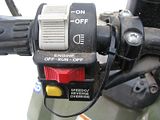
- Quads, hailing from Grand Marsh Observatory atop Elk Castle Hill
#1 is SNOW! It sucks. Enough to make it white between Christmas and New Year is ok, then it can go away. I tried to get out and cut firewood again today, but couldn't. I kept getting stuck. There's still 12"-18" in most places out there and since it was warm today, the snow turned soft and I kept sinking in. I've been able to get out there everyday, and even haul loads up the last week, because it's been cold and the snow was hard enough that I could stay on top with a loaded trailer. Today I never did make it out to where I have been cutting. Finally unhooked the trailer, wheeled it by hand through the snow to get it out of the way. Then I was able to back the Hawkeye up to where I could turn around and hook back up to the trailer and go home.

#2 is that stupid, damn, no brain, reverse override button on my Polaris Hawkeye ATV! If you've ever been stuck or plowed snow, you'll know what I'm talking about. What a pain in the ass. When you're stuck, and you're alone, you can't hold the damn button in and get off and push at the same time. And what makes it especially stupid is that without the button pushed you don't have 4WD in reverse! What the hell? Limiting the speed and power in reverse is bad enough, but what idiot decided it was a good idea to also turn off the 4WD in reverse unless you push the stupid button? And one more thing that adds to the overall stupidity of the damn thing is that the Hawkeye's button is also tied into controlling the speedometer/trip meter functions. So now it's even harder to disconnect the thing, unlike the older ones that were fairly easy to disable.

Fortunately I invented a "Stupid Reverse Override Button" overrider and it sure came in handy again today!

- Quads, hailing from Grand Marsh Observatory atop Elk Castle Hill
Subscribe to:
Posts (Atom)
